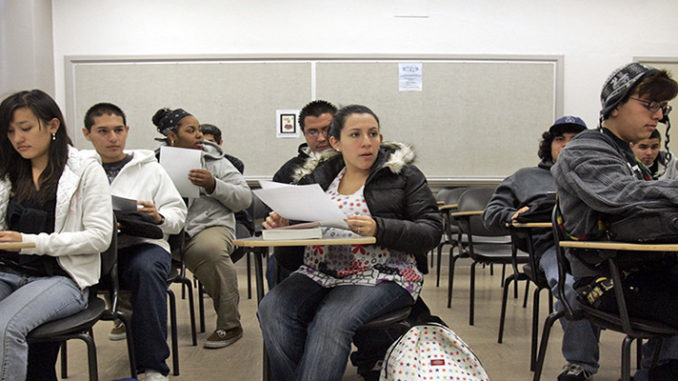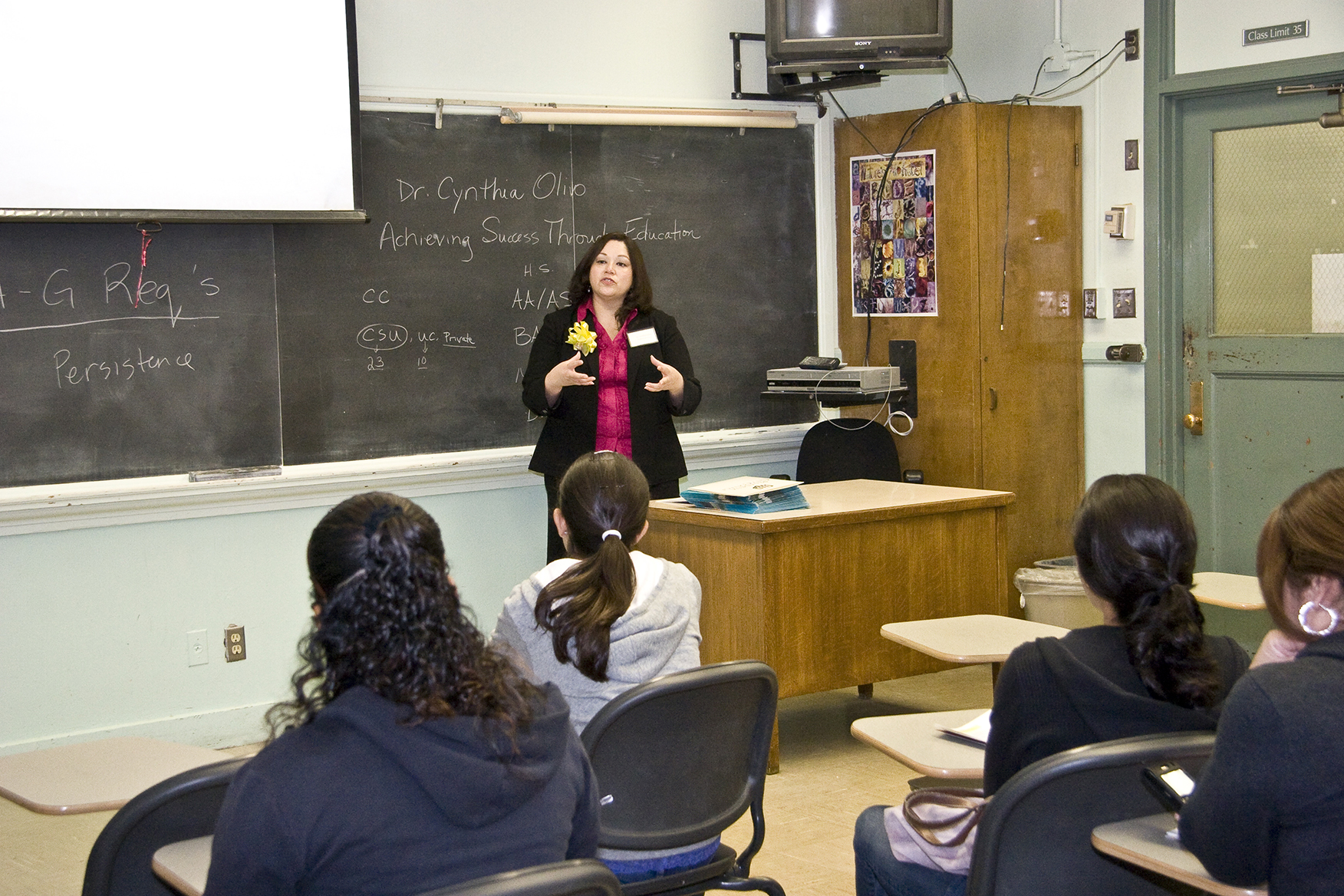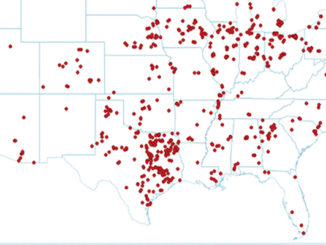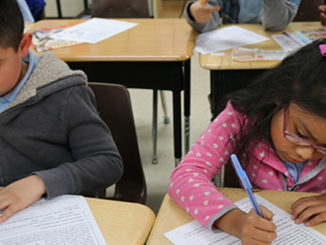
At Pasadena City College, small changes are adding up to big advances in achievement for minority students.
by Marcella Bonbardieri
Last fall, when introductory biology professors at Pasadena City College erased a rule banning late assignments or makeup exams, their colleagues joked that students would soon have imaginary grandmas perishing every weekend.
In years past, four in 10 Latino students and half of African American students in the class dropped out, failed or earned a D. The professors wondered whether they could improve students’ odds if they acknowledged that many of the students have jobs and other responsibilities that might interfere with a deadline, but shouldn’t make them question whether they belong in science or at this community college.
To communicate that, they erased from the syllabus some bold-faced admonitions: “There will be NO MAKE-UP exams. Late assignments will not be accepted.” The caveat that remained wasn’t new, but it may have landed differently without those stern words preceding it: “If you have an extenuating circumstance, please contact me by private message so we can discuss options.”
The flood of improbable sob stories that naysayers predicted never materialized. One professor noted that her gradebook looked different. There were a lot fewer zeros on projects, quizzes and other assignments.
“I’m getting messages saying, ‘Hey, professor Rodriguez, I had to work an extra shift tonight, is there any way that I can turn it in tomorrow morning?’” said Katie Rodriguez. “And you know what, they’ve turned it in in the morning.
“Whereas before,” Rodriguez continued, “that student might have just been like, ‘Oh, man, I only have 10 minutes to get this done. So, I’m just not going to do it.’”
Changing the late policy was among dozens of tweaks, over eight years and counting, to improve racial equity in just one class. That exhaustive effort and others like it across campus explain why this Southern California community college of 27,000 students is emerging as a national model for how to improve outcomes for students of color. And there is a grave need for such examples, as policymakers experiment with accountability for the poor outcomes that are the norm in higher education.
Only 36 percent of Hispanic students and 28 percent of black students who enroll at a community college go on to earn a degree, whether at that school or any other, within six years. Until now, there’s been no penalty for colleges with results as wretched as this and worse.
But that’s starting to change. California’s 115 community colleges make up the largest higher education system in the U.S., and they will soon face a penalty if their low-income students — who are disproportionately students of color — have low completion rates. At the federal level, Democrats in Congress and civil rights groups have pushed to impose accountability on colleges with the most egregious achievement gaps.
Pasadena City College has seen the rate at which Latino students complete associate degrees or certificates and transfer to four-year colleges rise by over 9 percentage points in five years, from 37 percent to 46 percent. That’s despite several years of crippling leadership turmoil, and during a decade when the proportion of students who are Latino rose from a third to half.
Those results are far from what anyone would call victory, and the 4 percent of students who are black have not seen similar gains. But it’s a bigger gain for Latino students than at any other large California community college and enough to turn heads among other community college leaders. Pasadena was a finalist this year for the biennial Aspen Prize for Community College Excellence—“basically the Oscars for great community colleges”—as President Barack Obama once said. Ángel Cabrera, prize jury co-chair and now president of Georgia Tech, noted that “there are few other community colleges in the nation that are as committed as Pasadena City College is to building a culture of equity that permeates every aspect of the college.”
Aspen found that of PCC students who transfer, 56 percent go on to earn a bachelor’s degree, well above the national average of 42 percent.
Part of why Pasadena stands out is that it offers an alternative approach to the handful of campuses usually held up as models for how to dramatically boost student success at a large, nonselective public college. The buzzy reforms today tend to be designed to change systems rather than people. These approaches include harnessing “big data” to identify students who are likely to stumble, a model made famous by Georgia State. Also ascendant is the concept of “guided pathways,” which boils down to telling students what they should take and when, to minimize their chances of getting lost in a thicket of unnecessary credits.
Pasadena has versions of those reforms, but leaders believe that building new systems will never be sufficient. Their core philosophy is that unless professors change what they do in the classroom with a deliberate focus on racial equity, even the most well-meaning and dedicated among them will discourage students of color with subtle messages that they don’t belong, that they aren’t expected to succeed, or that they are on their own to sink or swim.
It’s pretty much impossible to tell faculty how to run their classrooms, so the key for Pasadena has been to create opportunities for professors to recognize where they’ve fallen short, and to make them want to change what they do.
“It’s very personal, because when you talk about student success by race and ethnicity, if you’re an equity-minded person, what you’re saying is, ‘I am not doing something to meet the need of the student,’” said Cynthia Olivo, the college’s vice president of student services. “And that can be quite painful, because you’re in love with your profession, you want to help, and you intend to do well. But the reality is we have to learn to teach differently, we have to learn to serve differently.”
The typical professor receives little, if any, training on how to teach well. Not so at PCC, where new professors are asked to attend a seminar on equity-minded teaching for three hours every two weeks for a full year. That’s just one example of what Cabrera called PCC’s “culture of equity.” The campus boasts innumerable so-called FIGs—faculty inquiry groups–whose members volunteer to examine inequities in departments such as math, English as a second language and science. Among them is the group dedicated to that introductory biology class, Biology 11, which has been meeting every other Friday afternoon for years.
The director of professional development has what might be called a hearts-and-minds approach, in which instead of making pronouncements, he tries to offer faculty opportunities to reflect on their work and inspire one another. To that end, he has been assembling short “book clubs” to discuss psychologist Claude M. Steele’s Whistling Vivaldi, a book about “stereotype threat,” the phenomenon where students—and humans in general—do worse when they perceive that they are expected to do so.
The book offers a compelling case for why race should be a core concern for colleges. In one of Steele’s experiments, black Stanford students did just as well as white students when given a GRE exam that was described not as a test but as a “task” that didn’t measure intellectual ability. Yet when black students were given the GRE under typical test conditions that conjure stereotypes about lesser ability, they underperformed.
Many of these initiatives at Pasadena are only a few years old, and with white students’ completion and transfer rate still 20 percentage points higher than that of Latinos, college leaders know they have a long way to go. The extent to which they and their peers succeed will have substantial ramifications for the prosperity of a soon-to-be majority-minority nation in which two-thirds of job openings require some college. Young white adults in the U.S. have a college completion rate that would rank fourth in the world if they were their own country. The completion rate for African Americans, if they were a country, would be 27th, while Latinos would rank 35th, behind the likes of Turkey and Colombia.
Yet when the public hears about race in higher education, it is likely to be about the lawsuit challenging affirmative action at Harvard or the favoritism for rich white kids in sports like lacrosse and sailing that was revealed by the admissions cheating scandal. Those conversations are important, but the vast majority of students of color attend institutions where privilege is nowhere to be found and affirmative action is irrelevant, because every qualified student is admitted. Consider that Pasadena alone, with over 18,000 Latino students enrolling each year, teaches double the number of Latino undergraduates who can be found throughout the entire Ivy League.
Not far from the Lululemons and Cheesecake Factories of tony Old Pasadena and mere blocks from the world-renowned Caltech, Pasadena City College boasts stunning views of the San Gabriel Mountains and a reputation going back decades as one of California’s best community colleges. That helps explain why so many students trek to campus from poorer parts of greater Los Angeles. Jackie Robinson played four sports at what was then known as Pasadena Junior College before he headed to UCLA and the history books; he also called the city of Pasadena more hostile than the South.
The college’s glowing reputation belied racial disparities in student outcomes, and it also dimmed in 2015, when PCC’s accreditor took the extraordinary step of putting the college on probation because of virulent battles between a controversial president and faculty opponents. Another president and new faculty leaders restored calm, but Pasadena is proof that a college doesn’t need a visionary president or even stability to make meaningful improvements.

The central figure credited with advancing racial equity on campus is Cynthia Olivo, who rose through the ranks at PCC from a relatively junior dean to become vice president of student services. As Olivo, 47, often tells students, she is the granddaughter of migrant farmworkers, the daughter of a single mom, the first in her family to go to college. She still feels a vicarious sting from her mother’s experiences with racism in rural California in the 1960s, spurned for a seat on the school bus by a high school classmate who called her a “dirty Mexican.” She is proud that her mother smacked the girl the next day.
Olivo’s mother taught her to fight differently, she says, with books and words. Today, she often wields data, for example spearheading the creation of an online dashboard that shows success rates by race in every department, the kind of embarrassing results that few colleges make public. Olivo created new positions for directors of student equity and professional development and brought national experts on race in higher education to train faculty, including Estela Mara Bensimon, a University of Southern California professor who has been particularly influential in how colleges pursue “equity-mindedness.” Olivo also launched programs for neglected groups, including veterans, shortly after she came to PCC in 2008, and formerly incarcerated students today.
A cadre of faculty leaders have pushed racial equity alongside Olivo. These professors often describe epiphanies during which they first saw data on the college’s racial achievement gaps and gasped or shed tears; or when they went to an equity training and realized that they had been teaching films only about white men.
For Rodriguez, the gap in outcomes between Latino and black students on the one hand and white and Asian American students on the other was stark “just looking at my gradebook.” She was also bothered by the number of empty seats in her classroom at the end of the semester, and by the comments students made that “biology is really boring.” Biology 11 fulfills a science requirement for non-science majors, so it’s a crucial gateway to graduation for up to 2,000 students who enroll each year.
In 2011, the college ran a grant competition for faculty to develop projects to improve student success. Rodriguez, who joined the faculty in 2007, applied for funding for herself and one other instructor to pilot a few sections of Biology 11 based around projects rather than lectures. She got $15,000 and used it to buy equipment for a mock crime-scene lab and other hands-on activities.
“To give faculty that backing to say, ‘Go try and move the needle on this,’ is really helpful,” she said. “When I talk to people on other campuses, they’re like, ‘What, they just gave out money to people with good ideas?’ Well yeah, essentially they did.”
Just as a modest campus grant seeded the reinvention of Biology 11, there is a broader funding angle to PCC’s improved success. Over four years beginning in 2014, California gave community colleges $490 million to create and implement equity plans. Pasadena received about $7 million in total, a little more than 1 percent of its budget over that period, but pivotal in funding Olivo’s agenda. Yet researchers faulted the policy for handing out funding without setting targets or measuring outcomes. That’s part of why civil rights groups backed former Gov. Jerry Brown’s push for a new community college state funding formula that would braid in equity measures rather than treat the matter as an afterthought.
Under the new funding formula for California community colleges approved by lawmakers (over the objections of faculty groups), 10 percent of each college’s funding will be based on its outcomes, with more weight given to completions by low-income students. Another 20 percent of funding will be based on the portion of low-income students that each college enrolls. There is a grace period, but those with unfavorable results could see a hit to their budgets starting in three years.
Many states already have some form of performance-based funding to reward colleges for achieving higher graduation rates. But their mechanisms have usually ignored racial disparities and arguably harmed students of color, whether by punishing colleges that are already underfunded or by incentivizing institutions to become more selective. If California’s new formula helps narrow achievement gaps, it will offer a model for other states.
The federal government funds higher education more indirectly, mostly through financial aid to students, to the tune of over $120 billion a year. Perhaps remarkably to anyone who is more familiar with hospitals or K-12 schools, colleges effectively have no accountability for whether they use federal dollars to see students through to graduation and decent jobs. But there have been calls to change that this year, as Congress considers the first reauthorization in over a decade of the Higher Education Act.
Sen. Patty Murray, the top Democrat negotiating the bill with Republican Sen. Lamar Alexander, has said that the bill should require schools to enroll historically underrepresented students and offer the support they need to succeed. It’s not clear whether Congress will do that this year, but if it were to do so, available levers range from public disclosure of poor outcomes all the way up to revoking eligibility for federal financial aid.



